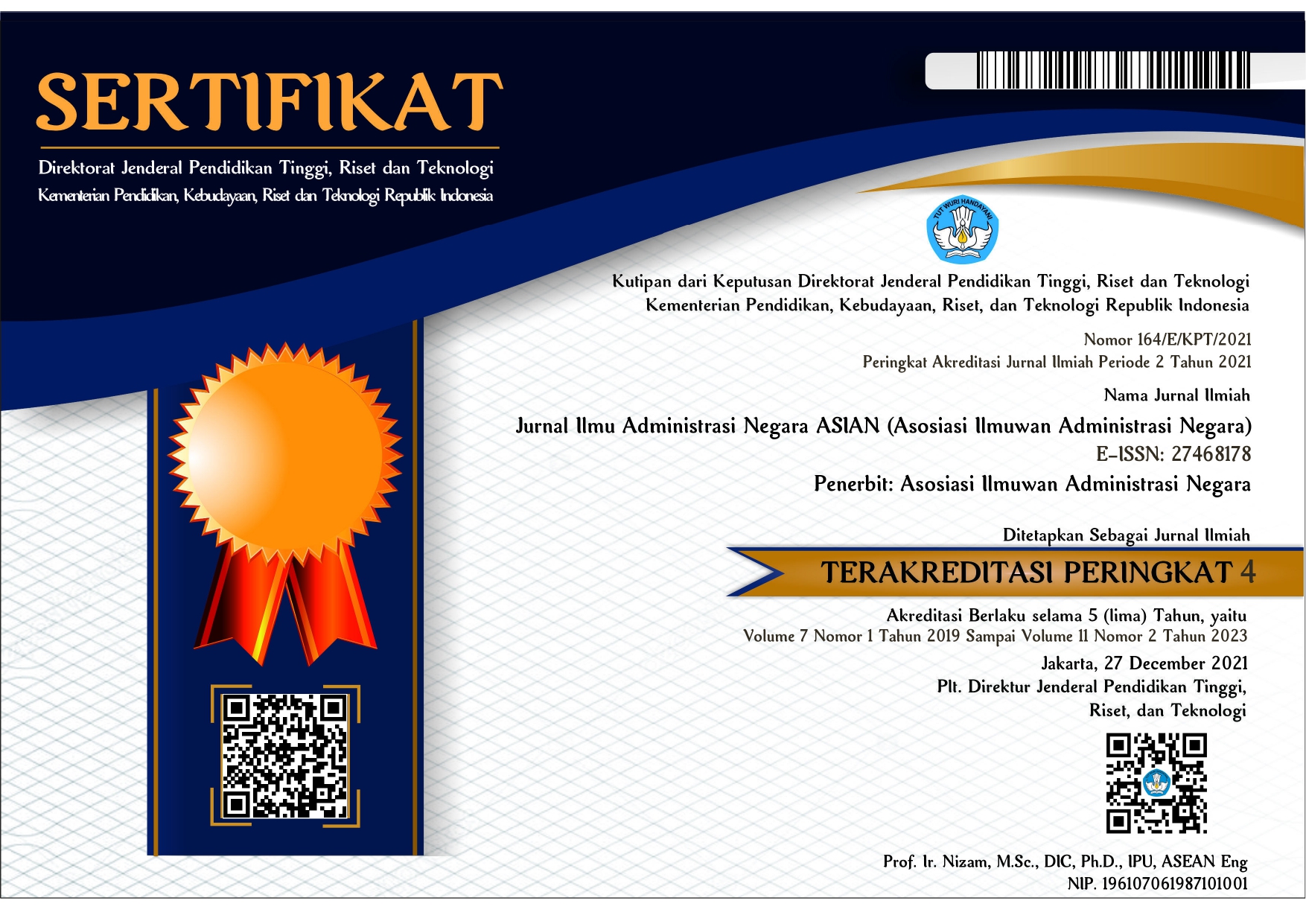Evaluasi Implementasi Sistem Zonasi Pendidikan (Studi Kasus di SMP Negeri 2 dan 7 Purwokerto)
 Abstract views: 806
,
Abstract views: 806
,
 PDF downloads: 1319
PDF downloads: 1319
Abstract
Since the 2017/2018 school year the Banyumas Regency government has been organizing Acceptance of New Students at the junior high school level, one of which uses the zoning system. This is motivated because the quality of education in Banyumas Regency especially at the JHS level is uneven, as evidenced by the naming of favorite and non-favorite schools in the community. Since the implementation of the zoning system in Banyumas Regency has created new problems. This study aims to evaluate the implementation of education zoning policies in JHS 2 and 7 Purwokerto based on the applicable policy guidelines and to determine the supporting and inhibiting factors of JHS 2 and 7 Purwokerto in achieving the objectives of the education zoning system policy. The method used in this research is qualitative. The selection of informants uses purposive sampling technique. Data collection uses in-depth interviews, observation and documentation study. Data analysis method used is an interactive analysis method. The results showed that JHS 2 Purwokerto as a favorite school and JHS as a non-favorite school had complied with the applicable policy guidelines, there were supporting factors which were the decentralization of power from the central government to regional governments and there were inhibiting factors namely the presence of blank spots and the desire of the community to enter favorite schools. The findings of the study are that JHS 7 Purwokerto as a non-favorite school has not been able to capture children of good quality because it is inferior to the 15% quota for achievement paths so that children who have good grades prefer to enroll in schools that are considered favorites. The school should also do active socialization and publication related to the achievements obtained to prospective students and parents of students, it is hoped that in this way it can generate trust to attend school at the school.
Downloads
References
Agus Purwanto, Erwan. 2012. Implementasi Kebijakan Publik Konsep dan Aplikasinya di Indonesia. Yogyakarta: Gava Media.
Arikunto, Suharsini. 2006. Metode Penelitian: Prosedur Penelitian Suatu Pendekatan Praktik. Jakarta: Rineka Cipta.
Dunn, Wiliam N. 2003. Pengantar Analisis Kebijakan Publik edisi ke-2. Jogjakarta: Gadjah Mada University Press.
Dye, Thomas R. 1981. Understanding Public Policy (4th Edition). Englewood Cliff, NJ: Prentice-Hall Inc, Ltd.
Indiahono, Dwiyanto. 2009. Kebijakan Publik Berbasis Dynamic Policy Analysis. Yogyakarta: Gava Media.
Islamy, M. Irfan. 2007. Prinsip-prinsip Perumusan Kebijaksanaan Negara, Cetakan ke Empat Belas. Jakarta: PT Bina Aksara
Kusumanegara, Solahuddin. 2010. Model dan Aktor dalam Proses Kebijakan Publik. Yogyakarta: Gava Media.
Mathew, Miles B, A. Michael Huberman, Johny Saldana. 2014. Quantitatif Data Analysis: A Methods Sourcebook Third Edition. Thousand Oaks, CA: Sage Publication Inc.
Moleong, Lexy J. 2015. Metodologi Penelitian Kualitatif. Bandung. PT Remaja Rosdakarya.
Nugroho, Riant. 2009. Analisis Kebijakan Publik. Jakarta: PT. Elex Media Komputindo Kelompok Gramedia.
Ripley, Rendal B. and Grace A. Franklin, 1986. Policy Implementation and Bureaucracy, second edition, the Dorsey Press, Chicago-Illionis.Grindle (1980)
Jurnal
Aprilia Lestari, Hermin dan Rosdiana, W. (2018). Pub Implementasi Kebijakan Penerimaan Peserta Didik Baru (PPDB) di SMA Negeri 4 Kota Madiun tahun 2017. Publika, 6(5).
Bintoro, R. F. A. (2018). Persepsi Masyarakat Terhadap Implementasi Kebijakan Zonasi Sekolah dalam Penerimaan Peserta Didik Baru (PPDB) Tingkat SMA Tahun Ajaran 2017/2018 di Kota Samarinda. Jurnal Riset Pembangunan, 1(1), 48-57
H.A.R. Tilaar. 2008. Kebijakan Pendidikan: Pengantar untuk Memahami Kebijakan Pendidikan dan Kebijakan Pendidikan sebagai Kebijakan Public. Yogyakarta: Pustaka Belajar
Juliana Macedo Reis Mercês and Profa Dra Marcia Maria Pereira Rendeiro. 2017. E-Learning As a Strategy For Implementation Of Public Policies. International Conferences WWW/Internet, ISBN: 978-989-8533-69-2
Maryono. 2015. The Implementation Of Character Education Policy At Junior High Schools And Islamic Junior High Schools In Pacitan. International Journal of Education and Research, Vol. 3 No. 5
Nurlailiyah Aris. 2019. Analisis Kebijakan Sistem Zonasi Terhadap Perilaku Siswa SMP di Yogyakarta. Jurnal Realita Vol. 17 No. 1.
Pangaribuan, Hariyanti. Implementasi Kebijakan Sistem Zonasi Penerimaan Peserta Didik Baru Jenjang SMP di Kabupaten Gesik. Prodi Manajemen Pendidikan, Fakultas Ilmu Pendidikan, Universitas Negeri Surabaya
Safarah Arafinna Azizah, Wibowo Budi Udik. (2018). Program Zonasi di Sekolah Dasar Sebagai Upaya Pemerataan Kualitas Pendidikan di Indonesia. Jurnal Lentera Pendidikan Vol. 21 No. 2.
Copyright (c) 2020 Jurnal Ilmu Administrasi Negara ASIAN (Asosiasi Ilmuwan Administrasi Negara)

This work is licensed under a Creative Commons Attribution-ShareAlike 4.0 International License.
Authors who publish with this journal agree to the following terms:
1. Copyright on any article is retained by the author(s).
2. The author grants the journal, right of first publication with the work simultaneously licensed under a Creative Commons Attribution License that allows others to share the work with an acknowledgment of the work’s authorship and initial publication in this journal.
3. Authors are able to enter into separate, additional contractual arrangements for the non-exclusive distribution of the journal’s published version of the work (e.g., post it to an institutional repository or publish it in a book), with an acknowledgment of its initial publication in this journal.
4. Authors are permitted and encouraged to post their work online (e.g., in institutional repositories or on their website) prior to and during the submission process, as it can lead to productive exchanges, as well as earlier and greater citation of published work.
5. The article and any associated published material is distributed under the Creative Commons Attribution-ShareAlike 4.0 International License









